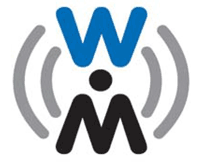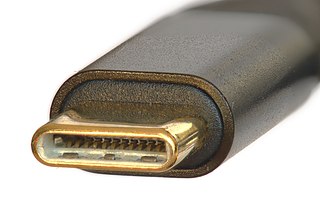
Universal Serial Bus (USB) is an industry standard that allows data exchange and delivery of power between many types of electronics. It specifies its architecture, in particular its physical interface, and communication protocols for data transfer and power delivery to and from hosts, such as personal computers, to and from peripheral devices, e.g. displays, keyboards, and mass storage devices, and to and from intermediate hubs, which multiply the number of a host's ports.

Digital Visual Interface (DVI) is a video display interface developed by the Digital Display Working Group (DDWG). The digital interface is used to connect a video source, such as a video display controller, to a display device, such as a computer monitor. It was developed with the intention of creating an industry standard for the transfer of uncompressed digital video content.

Serial digital interface (SDI) is a family of digital video interfaces first standardized by SMPTE in 1989. For example, ITU-R BT.656 and SMPTE 259M define digital video interfaces used for broadcast-grade video. A related standard, known as high-definition serial digital interface (HD-SDI), is standardized in SMPTE 292M; this provides a nominal data rate of 1.485 Gbit/s.

High-Definition Multimedia Interface (HDMI) is a proprietary audio/video interface for transmitting uncompressed video data and compressed or uncompressed digital audio data from an HDMI-compliant source device, such as a display controller, to a compatible computer monitor, video projector, digital television, or digital audio device. HDMI is a digital replacement for analog video standards.

DisplayPort (DP) is a proprietary digital display interface developed by a consortium of PC and chip manufacturers and standardized by the Video Electronics Standards Association (VESA). It is primarily used to connect a video source to a display device such as a computer monitor. It can also carry audio, USB, and other forms of data.

The physical-layer specifications of the Ethernet family of computer network standards are published by the Institute of Electrical and Electronics Engineers (IEEE), which defines the electrical or optical properties and the transfer speed of the physical connection between a device and the network or between network devices. It is complemented by the MAC layer and the logical link layer. An implementation of a specific physical layer is commonly referred to as PHY.

The WiMedia Alliance was a non-profit industry trade group that promoted the adoption, regulation, standardization and multi-vendor interoperability of ultra-wideband (UWB) technologies. It existed from about 2002 through 2009.
WirelessHD, also known as UltraGig, is a proprietary standard owned by Silicon Image for wireless transmission of high-definition video content for consumer electronics products. The consortium currently has over 40 adopters; key members behind the specification include Broadcom, Intel, LG, Panasonic, NEC, Samsung, SiBEAM, Sony, Philips and Toshiba. The founders intend the technology to be used for Consumer Electronic devices, PCs, and portable devices.
Mobile High-Definition Link (MHL) is an industry standard for a mobile audio/video interface that allows the connection of smartphones, tablets, and other portable consumer electronics devices to high-definition televisions (HDTVs), audio receivers, and projectors. The standard was designed to share existing mobile device connectors, such as Micro-USB, and avoid the need to add video connectors on devices with limited space for them.
Wireless Home Digital Interface (WHDI) is a consumer electronic specification for a wireless HDTV connectivity throughout the home.
Uncompressed video is digital video that either has never been compressed or was generated by decompressing previously compressed digital video. It is commonly used by video cameras, video monitors, video recording devices, and in video processors that perform functions such as image resizing, image rotation, deinterlacing, and text and graphics overlay. It is conveyed over various types of baseband digital video interfaces, such as HDMI, DVI, DisplayPort and SDI. Standards also exist for the carriage of uncompressed video over computer networks.
Audio connectors and video connectors are electrical or optical connectors for carrying audio or video signals. Audio interfaces or video interfaces define physical parameters and interpretation of signals. For digital audio and digital video, this can be thought of as defining the physical layer, data link layer, and most or all of the application layer. For analog audio and analog video these functions are all represented in a single signal specification like NTSC or the direct speaker-driving signal of analog audio.
WiGig, alternatively known as 60 GHz Wi-Fi, refers to a set of 60 GHz wireless network protocols. It includes the current IEEE 802.11ad standard and also the IEEE 802.11ay standard.

IEEE 1394 is an interface standard for a serial bus for high-speed communications and isochronous real-time data transfer. It was developed in the late 1980s and early 1990s by Apple in cooperation with a number of companies, primarily Sony and Panasonic. It is most commonly known by the name FireWire (Apple), though other brand names exist such as i.LINK (Sony), and Lynx.
MOST is a high-speed multimedia network technology for the automotive industry. It can be used for applications inside or outside the car. The serial MOST bus uses a daisy-chain topology or ring topology and synchronous serial communication to transport audio, video, voice and data signals via plastic optical fiber (POF) or electrical conductor physical layers.

USB-C, or USB Type-C, is a 24-pin connector that supersedes previous USB connectors and can carry audio, video and other data, e.g., to drive multiple displays or to store a backup to an external drive. It can also provide and receive power, such as powering a laptop or a mobile phone. It is applied not only by USB technology, but also by other protocols, including Thunderbolt, PCIe, HDMI, DisplayPort, and others. It is extensible to support future standards.
IEEE 802.3bz, NBASE-T and MGBASE-T are standards released in 2016 for Ethernet over twisted pair at speeds of 2.5 and 5 Gbit/s. These use the same cabling as the ubiquitous Gigabit Ethernet, yet offer higher speeds. The resulting standards are named 2.5GBASE-T and 5GBASE-T.
Valens Semiconductor (Valens) is an Israeli fabless manufacturing company providing semiconductors for the automotive and audio-video industries. Valens provides semiconductor products for the distribution of uncompressed ultra-high-definition (UHD) multimedia content and in-vehicle connectivity applications. The company is a member of the MIPI Alliance and developed the first-to-market chipset that is compliant with the MIPI A-PHY standard. Valens invented the technology behind the HDBaseT standard and is a co-founder of the HDBaseT Alliance.
Gigabit Multimedia Serial Link, commonly referred to as GMSL, is a serial link technology that is used for video distribution in cars. It was developed by Maxim Integrated. Maxim Integrated was acquired by Analog Devices in 2021.










